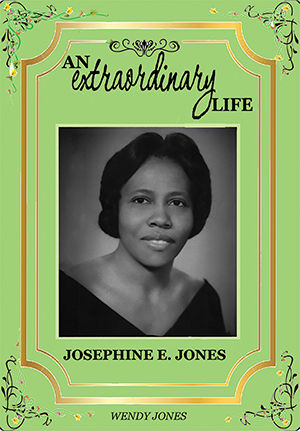Book Review: An Extraordinary Life: Josephine E. Jones
Book Reviewed by Brenda M. Greene
Wendy Jones has written a tribute to her late mother Josephine E. Jones. Her mother was part of the Great Migration, depicted so comprehensively in Isabel Wilkerson’s The Warmth of Other Suns. As you read the biography, you are reminded of the sacrifices made by so many of our parents, grandparents, and great grandparents. You are reminded of what it means to struggle and to persevere despite the many obstacles that face Black people in these United States of America.
An Extraordinary Life is the story of a woman who raised a daughter in the midst of the civil rights movement, the gentrification of Harlem, and the women’s movement in a racially constructed America. A sharecropper’s daughter, Josephine E. Jones, worked her way from the racially segregated south, migrated to New York City and became a domestic worker, a community activist, a specialist in the Culinary Arts, and an astute catering manager in Fortune 500 companies. She had a strong work ethic and realized the importance of education for herself and her daughter. Despite financial and family burdens and obstacles that impacted her quality of life, she persisted and eventually sent her daughter to Yale University.
Wendy Jones helps us to imagine the life of her mother through her mother’s voice, family photos and high quality photos of her mother’s culinary dishes. Readers obtain a first-hand view of what it was like to work and live on a farm in Cross Hill, South Carolina, the interrupted school year, the inadequate schooling for Black youth under the Jim Crow system, the life of the domestic worker, the housing shortage in Harlem, and the challenge of managing the responsibilities of one’s own family as well as of one’s siblings.
As readers we are drawn into stories that move us because of the emotions or because of a dramatic rendering of events. We want to feel and imagine the event. We do not want someone simply to tell the story. As I read the text, I understood what the narrator, Josephine Jones, was going through but I did not feel her sadness, passion, desire, despair, joy and other sentiments that conveyed her interior life. I was told about this life, but found it difficult to make an emotional connection to this life through the dialogue and narration. The adage to writers that they should “show and not tell” continued to enter my mind. Yes, Josephine E. Jones was an extraordinary woman, but why is her story important to tell and why would others want to read it. Are there some literary techniques or renderings that would have helped to draw me into this narrative?
As a writer, educator and mother, I want people to know about my mother who sacrificed to raise three children, but I would be hard pressed to write a biography on my mother for the general public. There are many powerful and selfless mothers who have sacrificed and become leaders in their communities. If however, I chose to write my mother’s story, I would be sure to employ literary techniques that would draw the reader in and provide dramatic renditions of her experiences. These literary techniques and dramatic renditions of the life of Josephine E. Jones are missing from An Extraordinary Life.
Brenda M. Greene is Professor of English and Executive Director of the Center for Black Literature at Medgar Evers College, CUNY.

